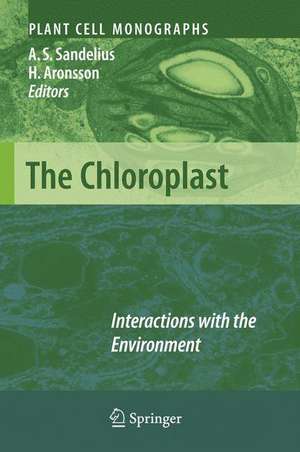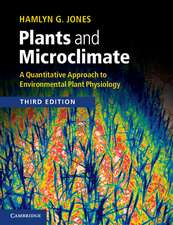The Chloroplast: Interactions with the Environment: Plant Cell Monographs, cartea 13
Editat de Anna Stina Sandelius, Henrik Aronssonen Limba Engleză Hardback – 4 dec 2008
| Toate formatele și edițiile | Preț | Express |
|---|---|---|
| Paperback (1) | 945.47 lei 6-8 săpt. | |
| Springer Berlin, Heidelberg – 30 noi 2010 | 945.47 lei 6-8 săpt. | |
| Hardback (1) | 952.89 lei 6-8 săpt. | |
| Springer Berlin, Heidelberg – 4 dec 2008 | 952.89 lei 6-8 săpt. |
Din seria Plant Cell Monographs
- 18%
 Preț: 947.04 lei
Preț: 947.04 lei - 24%
 Preț: 797.37 lei
Preț: 797.37 lei - 18%
 Preț: 957.62 lei
Preț: 957.62 lei - 18%
 Preț: 943.88 lei
Preț: 943.88 lei - 24%
 Preț: 790.00 lei
Preț: 790.00 lei - 18%
 Preț: 948.16 lei
Preț: 948.16 lei - 18%
 Preț: 950.84 lei
Preț: 950.84 lei - 18%
 Preț: 1381.43 lei
Preț: 1381.43 lei - 18%
 Preț: 942.63 lei
Preț: 942.63 lei - 18%
 Preț: 1226.73 lei
Preț: 1226.73 lei - 18%
 Preț: 952.89 lei
Preț: 952.89 lei - 18%
 Preț: 943.43 lei
Preț: 943.43 lei - 18%
 Preț: 956.03 lei
Preț: 956.03 lei - 18%
 Preț: 1121.76 lei
Preț: 1121.76 lei - 18%
 Preț: 1386.48 lei
Preț: 1386.48 lei - 15%
 Preț: 634.00 lei
Preț: 634.00 lei - 24%
 Preț: 785.83 lei
Preț: 785.83 lei - 18%
 Preț: 953.20 lei
Preț: 953.20 lei - 18%
 Preț: 952.09 lei
Preț: 952.09 lei - 18%
 Preț: 950.66 lei
Preț: 950.66 lei - 18%
 Preț: 945.30 lei
Preț: 945.30 lei - 18%
 Preț: 948.79 lei
Preț: 948.79 lei - 18%
 Preț: 1231.47 lei
Preț: 1231.47 lei
Preț: 952.89 lei
Preț vechi: 1162.06 lei
-18% Nou
Puncte Express: 1429
Preț estimativ în valută:
182.33€ • 190.88$ • 150.87£
182.33€ • 190.88$ • 150.87£
Carte tipărită la comandă
Livrare economică 07-21 aprilie
Preluare comenzi: 021 569.72.76
Specificații
ISBN-13: 9783540686927
ISBN-10: 3540686924
Pagini: 314
Ilustrații: XIV, 300 p. 30 illus., 4 illus. in color.
Dimensiuni: 155 x 235 x 21 mm
Greutate: 0.66 kg
Ediția:2009
Editura: Springer Berlin, Heidelberg
Colecția Springer
Seria Plant Cell Monographs
Locul publicării:Berlin, Heidelberg, Germany
ISBN-10: 3540686924
Pagini: 314
Ilustrații: XIV, 300 p. 30 illus., 4 illus. in color.
Dimensiuni: 155 x 235 x 21 mm
Greutate: 0.66 kg
Ediția:2009
Editura: Springer Berlin, Heidelberg
Colecția Springer
Seria Plant Cell Monographs
Locul publicării:Berlin, Heidelberg, Germany
Public țintă
ResearchCuprins
Diversity and Evolution of Plastids and Their Genomes.- The Chloroplast Envelope Proteome and Lipidome.- The Chloroplast Protein Import Apparatus, Its Components, and Their Roles.- Chloroplast Membrane Lipid Biosynthesis and Transport.- The Role of Metabolite Transporters in Integrating Chloroplasts with the Metabolic Network of Plant Cells.- Retrograde Signalling.- Plastid Division Regulation and Interactions with the Environment.- Chloroplast Photorelocation Movement.- A Sentinel Role for Plastids.
Notă biografică
Anna Stina Sandelius pursued her PhD degree in Plant Physiology with Prof Conny Liljenberg at the University of Gothenburg. She graduated in 1983 and spent the following year and a half with Prof D. James Morré at Purdue University in West Lafayette, Indiana, USA. She returned to the University of Gothenburg in 1985, where she attained full professorship in 1999. She is presently vice dean of the science faculty. As a graduate student, she studied the role of galactolipids during chloroplast development. She then switched to the plasma membrane and its lipid metabolism and supply, initially focusing on inositolphospholipids. The interest in lipid trafficking brought back plastids as an object of study and, thanks to her group’s recent discovery that the plasma membrane uses plastid-synthesized galactolipids to replace phospholipids during phosphate-limiting cultivation, the two objects of study, along with the endoplasmic reticulum, have been brought together in efforts to elucidate lipid trafficking between plastids and the plasma membrane.
Henrik Aronsson pursued his PhD degree in Plant Physiology with Dr Clas Dahlin at the University of Gothenburg. He graduated in 2001 and spent the following year and a half as a postdoctoral student in Dr Paul Jarvis’ group at Leicester University. The next year he spent at Gotland University and Skövde University as senior lecturer. He then returned to the University of Gothenburg in 2004, where he attained associate professorship in 2007. As a graduate student, he studied plastid protein targeting of the light-dependent enzyme NADPH: protochlorophyllide reductase (POR) both to the envelope and the internal membrane system. He then switched to studying the chloroplast protein import machinery with a focus on the components that make up the machinery. His group has recently started studying the plastid vesicle membrane trafficking between the envelope and the internal membrane system with emphasis onputative proteins involved in the process.
Henrik Aronsson pursued his PhD degree in Plant Physiology with Dr Clas Dahlin at the University of Gothenburg. He graduated in 2001 and spent the following year and a half as a postdoctoral student in Dr Paul Jarvis’ group at Leicester University. The next year he spent at Gotland University and Skövde University as senior lecturer. He then returned to the University of Gothenburg in 2004, where he attained associate professorship in 2007. As a graduate student, he studied plastid protein targeting of the light-dependent enzyme NADPH: protochlorophyllide reductase (POR) both to the envelope and the internal membrane system. He then switched to studying the chloroplast protein import machinery with a focus on the components that make up the machinery. His group has recently started studying the plastid vesicle membrane trafficking between the envelope and the internal membrane system with emphasis onputative proteins involved in the process.
Textul de pe ultima copertă
Chloroplasts are vital for life as we know it. At the leaf cell level, it is common knowledge that a chloroplast interacts with its surroundings – but this knowledge is often limited to the benefits of oxygenic photosynthesis and that chloroplasts provide reduced carbon, nitrogen and sulphur. This book presents the intricate interplay between chloroplasts and their immediate and more distant environments. The topic is explored in chapters covering aspects of evolution, the chloroplast/cytoplasm barrier, transport, division, motility and bidirectional signalling. Taken together, the contributed chapters provide an exciting insight into the complexity of how chloroplast functions are related to cellular and plant-level functions. The recent rapid advances in the presented research areas, largely made possible by the development of molecular techniques and genetic screens of an increasing number of plant model systems, make this interaction a topical issue.
Caracteristici
Presents the chloroplast as an organelle with multiple roles especially interaction and communication with their surroundings In depth analysis of chloroplasts and their vital roles in addition to oxygenic photosynthesis It highlights the different aspects such as plastid evolution, the chloroplast/cytoplasm barrier, transport into and out of chloroplasts, chloroplast division and motility and signalling between chloroplasts and their environment Includes supplementary material: sn.pub/extras






